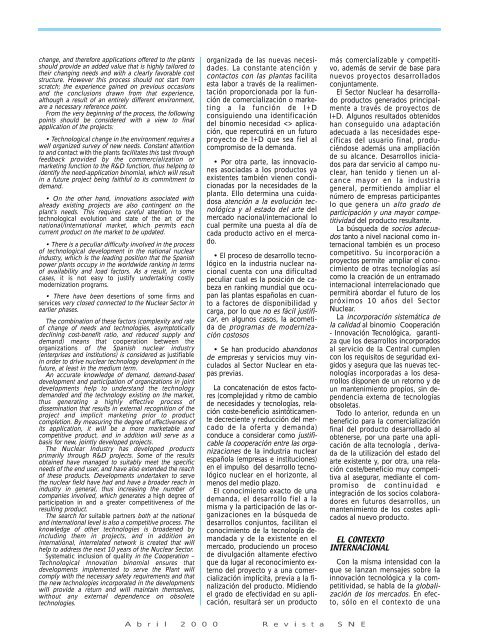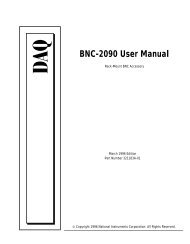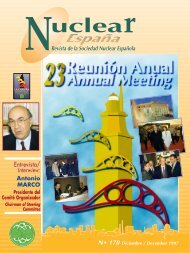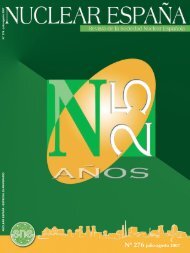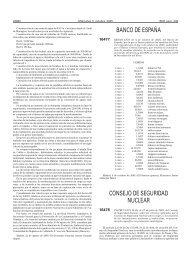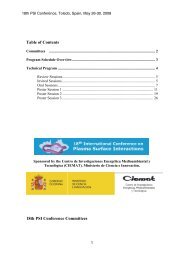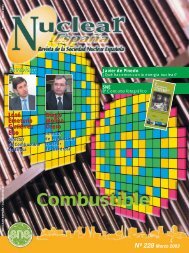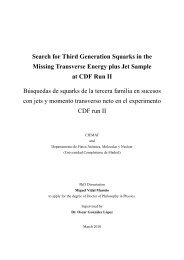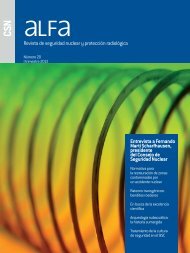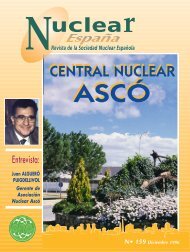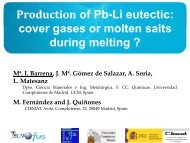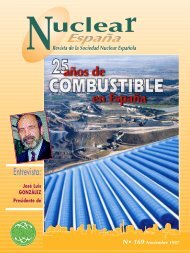EntrEntr evista/evista/ InterInter viewview
EntrEntr evista/evista/ InterInter viewview
EntrEntr evista/evista/ InterInter viewview
Create successful ePaper yourself
Turn your PDF publications into a flip-book with our unique Google optimized e-Paper software.
change, and therefore applications offered to the plants<br />
should provide an added value that is highly tailored to<br />
their changing needs and with a clearly favorable cost<br />
structure. However this process should not start from<br />
scratch; the experience gained on previous occasions<br />
and the conclusions drawn from that experience,<br />
although a result of an entirely different environment,<br />
are a necessary reference point.<br />
From the very beginning of the process, the following<br />
points should be considered with a view to final<br />
application of the projects:<br />
• Technological change in the environment requires a<br />
well organized survey of new needs. Constant attention<br />
to and contact with the plants facilitates this task through<br />
feedback provided by the commercialization or<br />
marketing function to the R&D function, thus helping to<br />
identify the need-application binomial, which will result<br />
in a future project being faithful to its commitment to<br />
demand.<br />
• On the other hand, innovations associated with<br />
already existing projects are also contingent on the<br />
plant’s needs. This requires careful attention to the<br />
technological evolution and state of the art of the<br />
national/international market, which permits each<br />
current product on the market to be updated.<br />
• There is a peculiar difficulty involved in the process<br />
of technological development in the national nuclear<br />
industry, which is the leading position that the Spanish<br />
power plants occupy in the worldwide ranking in terms<br />
of availability and load factors. As a result, in some<br />
cases, it is not easy to justify undertaking costly<br />
modernization programs.<br />
• There have been desertions of some firms and<br />
services very closed connected to the Nuclear Sector in<br />
earlier phases.<br />
The combination of these factors (complexity and rate<br />
of change of needs and technologies, asymptotically<br />
declining cost-benefit ratio, and reduced supply and<br />
demand) means that cooperation between the<br />
organizations of the Spanish nuclear industry<br />
(enterprises and institutions) is considered as justifiable<br />
in order to drive nuclear technology development in the<br />
future, at least in the medium term.<br />
An accurate knowledge of demand, demand-based<br />
development and participation of organizations in joint<br />
developments help to understand the technology<br />
demanded and the technology existing on the market,<br />
thus generating a highly effective process of<br />
dissemination that results in external recognition of the<br />
project and implicit marketing prior to product<br />
completion. By measuring the degree of effectiveness of<br />
its application, it will be a more marketable and<br />
competitive product, and in addition will serve as a<br />
basis for new, jointly developed projects.<br />
The Nuclear Industry has developed products<br />
primarily through R&D projects. Some of the results<br />
obtained have managed to suitably meet the specific<br />
needs of the end user, and have also extended the reach<br />
of these products. Developments undertaken to serve<br />
the nuclear field have had and have a broader reach in<br />
industry in general, thus increasing the number of<br />
companies involved, which generates a high degree of<br />
participation in and a greater competitiveness of the<br />
resulting product.<br />
The search for suitable partners both at the national<br />
and international level is also a competitive process. The<br />
knowledge of other technologies is broadened by<br />
including them in projects, and in addition an<br />
international, interrelated network is created that will<br />
help to address the next 10 years of the Nuclear Sector.<br />
Systematic inclusion of quality in the Cooperation –<br />
Technological Innovation binomial ensures that<br />
developments implemented to serve the Plant will<br />
comply with the necessary safety requirements and that<br />
the new technologies incorporated in the developments<br />
will provide a return and will maintain themselves,<br />
without any external dependence on obsolete<br />
technologies.<br />
organizada de las nuevas necesidades.<br />
La constante atención y<br />
contactos con las plantas facilita<br />
esta labor a través de la realimentación<br />
proporcionada por la función<br />
de comercialización o marketing<br />
a la función de I+D<br />
consiguiendo una identificación<br />
del binomio necesidad aplicación,<br />
que repercutirá en un futuro<br />
proyecto de I+D que sea fiel al<br />
compromiso de la demanda.<br />
• Por otra parte, las innovaciones<br />
asociadas a los productos ya<br />
existentes también vienen condicionadas<br />
por la necesidades de la<br />
planta. Ello determina una cuidadosa<br />
atención a la evolución tecnológica<br />
y al estado del arte del<br />
mercado nacional/internacional lo<br />
cual permite una puesta al día de<br />
cada producto activo en el mercado.<br />
• El proceso de desarrollo tecnológico<br />
en la industria nuclear nacional<br />
cuenta con una dificultad<br />
peculiar cual es la posición de cabeza<br />
en ranking mundial que ocupan<br />
las plantas españolas en cuanto<br />
a factores de disponibilidad y<br />
carga, por lo que no es fácil justificar,<br />
en algunos casos, la acometida<br />
de programas de modernización<br />
costosos<br />
• Se han producido abandonos<br />
de empresas y servicios muy vinculados<br />
al Sector Nuclear en etapas<br />
previas.<br />
La concatenación de estos factores<br />
(complejidad y ritmo de cambio<br />
de necesidades y tecnologías, relación<br />
coste-beneficio asintóticamente<br />
decreciente y reducción del mercado<br />
de la oferta y demanda)<br />
conduce a considerar como justificable<br />
la cooperación entre las organizaciones<br />
de la industria nuclear<br />
española (empresas e instituciones)<br />
en el impulso del desarrollo tecnológico<br />
nuclear en el horizonte, al<br />
menos del medio plazo.<br />
El conocimiento exacto de una<br />
demanda, el desarrollo fiel a la<br />
misma y la participación de las organizaciones<br />
en la búsqueda de<br />
desarrollos conjuntos, facilitan el<br />
conocimiento de la tecnología demandada<br />
y de la existente en el<br />
mercado, produciendo un proceso<br />
de divulgación altamente efectivo<br />
que da lugar al reconocimiento externo<br />
del proyecto y a una comercialización<br />
implícita, previa a la finalización<br />
del producto. Midiendo<br />
el grado de efectividad en su aplicación,<br />
resultará ser un producto<br />
más comercializable y competitivo,<br />
además de servir de base para<br />
nuevos proyectos desarrollados<br />
conjuntamente.<br />
El Sector Nuclear ha desarrollado<br />
productos generados principalmente<br />
a través de proyectos de<br />
I+D. Algunos resultados obtenidos<br />
han conseguido una adaptación<br />
adecuada a las necesidades específicas<br />
del usuario final, produciéndose<br />
además una ampliación<br />
de su alcance. Desarrollos iniciados<br />
para dar servicio al campo nuclear,<br />
han tenido y tienen un alcance<br />
mayor en la industria<br />
general, permitiendo ampliar el<br />
número de empresas participantes<br />
lo que genera un alto grado de<br />
participación y una mayor competitividad<br />
del producto resultante.<br />
La búsqueda de socios adecuados<br />
tanto a nivel nacional como internacional<br />
también es un proceso<br />
competitivo. Su incorporación a<br />
proyectos permite ampliar el conocimiento<br />
de otras tecnologías así<br />
como la creación de un entramado<br />
internacional interrelacionado que<br />
permitirá abordar el futuro de los<br />
próximos 10 años del Sector<br />
Nuclear.<br />
La incorporación sistemática de<br />
la calidad al binomio Cooperación<br />
- Innovación Tecnológica, garantiza<br />
que los desarrollos incorporados<br />
al servicio de la Central cumplen<br />
con los requisitos de seguridad exigidos<br />
y asegura que las nuevas tecnologías<br />
incorporadas a los desarrollos<br />
disponen de un retorno y de<br />
un mantenimiento propios, sin dependencia<br />
externa de tecnologías<br />
obsoletas.<br />
Todo lo anterior, redunda en un<br />
beneficio para la comercialización<br />
final del producto desarrollado al<br />
obtenerse, por una parte una aplicación<br />
de alta tecnología , derivada<br />
de la utilización del estado del<br />
arte existente y, por otra, una relación<br />
coste/beneficio muy competitiva<br />
al asegurar, mediante el compromiso<br />
de continuidad e<br />
integración de los socios colaboradores<br />
en futuros desarrollos, un<br />
mantenimiento de los costes aplicados<br />
al nuevo producto.<br />
EL CONTEXTO<br />
INTERNACIONAL<br />
Con la misma intensidad con la<br />
que se lanzan mensajes sobre la<br />
innovación tecnológica y la competitividad,<br />
se habla de la globalización<br />
de los mercados. En efecto,<br />
sólo en el contexto de una<br />
A b r i l 2 0 0 0<br />
R e v i s t a S N E


